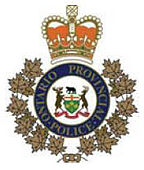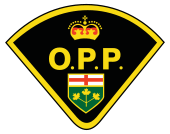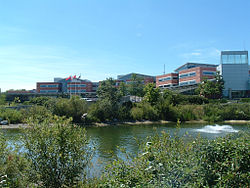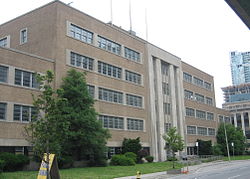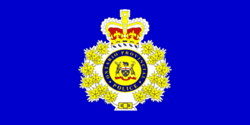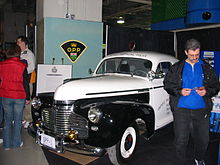- Ontario Provincial Police
-
"O.P.P." redirects here. For the Naughty by Nature song, see O.P.P. (song).
Ontario Provincial Police
Police provinciale de l'OntarioAbbreviation OPP Heraldic badge of the OPP Shoulder flash of the OPP Motto Safe Communities, A Secure Ontario Agency overview Formed 1909 Employees 7,383 Volunteers 853 Auxiliary Constables [1] Annual budget $786,602,800 (2006-07) Legal personality Governmental: Government agency Jurisdictional structure Operations jurisdiction* Province of Ontario, Canada Governing body The Queen in Right of Ontario Constituting instrument Ontario Police Services Act General nature Operational structure Headquarters 777 Memorial Ave, Orillia, Ontario Police Constables 5,618[1] Civilians 1,765 [1] Elected officer responsible Rick Bartolucci, Minister of Community Safety and Correctional Services Agency executive Christopher D. Lewis, Commissioner Facilities Stations 163 Website OPP Footnotes * Divisional agency: Division of the country, over which the agency has usual operational jurisdiction. The Ontario Provincial Police (O.P.P.) (French: Police provinciale de l'Ontario) is the Provincial Police service for the province of Ontario, Canada.
Contents
Overview
The OPP is the the largest deployed police force in Ontario , and the second largest in Canada. The service is responsible for providing policing services throughout the province in areas lacking local police forces. It also provides specialized support to smaller municipal police forces, investigates provincewide and cross-jurisdictional crimes, patrols provincial highways (including Ontario's 400-Series Highways) and is responsible for many of the waterways in the province. The OPP also works with other provincial agencies, including the Ministry of Transportation and Ministry of Natural Resources to enforce highway safety and conservation regulations, respectively. Finally, OPP officers provide security at the Ontario Legislature at Queen's Park in Toronto.
The OPP is one of three provincial police forces in Canada. The others are the Royal Newfoundland Constabulary in Newfoundland and Labrador and the Sûreté du Québec in Quebec.
History
At the First Parliament of Upper Canada on September 17, 1792, at Niagara-on-the-Lake, provision was made for the formation of a 'police system'. Initially, policing jurisdictions were limited to districts, townships, and parishes. In 1871, four years after Confederation, the Constables' Act extended jurisdiction and gave designated police members authorization to act throughout the province. The first salaried Provincial Constable appointed to act as Detective for the Government of Ontario was John Wilson Murray (1840–1906), hired in 1875. Murray was joined by two additional detectives in 1897, marking the beginnings of the Criminal Investigation Branch. However, for the most part, policing outside of Ontario's cities was non-existent.
With the discovery of silver in Cobalt and gold in Timmins, lawlessness was increasingly becoming a problem in northern Ontario. Police constables were gradually introduced in various areas, until an Order in Council decreed the establishment of a permanent organization of salaried constables designated as The Ontario Provincial Police on October 13, 1909. It consisted of 45 men under the direction of Superintendent Joseph E. Rogers. The starting salary for constables was $400.00 per annum, increased to $900.00 in 1912. The first O.P.P. detachment was located in Bala, Ontario.
In 1921, restructuring was undertaken with the passing of the Provincial Police Force Act. The title of the commanding officer was changed to Commissioner and given responsibility for enforcing the provisions of the Ontario Temperance Act and other liquor regulations. Major-General Harry Macintyre Cawthra-Elliot was appointed as the first Commissioner. Christopher D. Lewis is the current Commissioner, replacing Julian Fantino, who retired July 31, 2010. Fantino took office in October 2006, succeeding Gwen M. Boniface.
The O.P.P.'s first line of duty death occurred in 1923 when escaped convict Leo Rogers shot and killed Sergeant John Urquhart near North Bay. Rogers, who was later killed in a shootout with O.P.P. officers, had already mortally wounded North Bay City Constable Fred Lefebvre.
The first O.P.P. motorcycle patrol was introduced in 1928, phased out in 1942 and then reintroduced in 1949. The first marked O.P.P. patrol car was introduced in 1941.
During World War II, the Veterans Guard was formed. This was a body of volunteers (primarily World War I veterans), under the supervision of regular police members, protected vulnerable hydroelectric plants and the Welland Ship Canal.
Volunteers continue to serve with the O.P.P. Auxiliary, which was originally formed in 1960 by an Order in Council when the program absorbed the Emergency Measures Organization who were trained in crowd control and first aid. It is recognized that O.P.P. auxiliary constables shall not be utilized to replace regular members in any duties. The Ontario Police Services Act does, however, provide for instances when the Auxiliary Member may have the authority of a Police Officer. This can occur in an emergency situation where the O.P.P. requires additional strength to cope with a special occasion or event.[2]
Women joined the uniform ranks in 1974.
In 1985, the O.P.P. uniform was made more distinctive with the introduction of a blue trouser stripe to match a blue peak cap band.
In 1995, General Headquarters moved into its new facility in Orillia and for the first time in the history of the organization, all Bureaus were in one building.
During the 1990s, officer uniforms changed with darker shirts and matching body armour vests were introduced. In the early years the OPP wore olive green coloured uniforms.
From 1909 to 1930s, the OPP used stetson as the official headgear and from 1997 to 2008. From 1930s to 1997 the peaked cap was worn and has been returned to service after 2008. During 1997 to 2008, the peaked cap was still worn by commanding officers of the force.
Organization and operations
The Ontario Provincial Police is responsible for providing policing services over one million square kilometres of land and 174 000 km2 of water to a population of 2.3 million people (3.6 million in the summer months). Currently, the O.P.P. has over 5,618 uniformed, 853 auxiliary and 1,765 civilian personnel.[1] The vehicle fleet consists of 2,290 vehicles, 114 marine vessels, 286 snow and all-terrain vehicles, 2 helicopters and 2 fixed-wing aircraft.
The province is divided into six operational regions:
- Central (headquartered in Orillia)
- East (headquartered in Smiths Falls)
- Highway Safety Division - HSD (headquartered in Aurora)
- North-East (headquartered in North Bay)
- North-West (headquartered in Thunder Bay)
- West (headquartered in London)
Field and operational services are provided from 163 police stations and satellite locations throughout Ontario. OPP stations are called "detachments."
The OPP General Headquarters are located in Orillia. Until 1995, the administration and headquarters divisions operated out of a number of buildings in Toronto. From 1973 to 1995 the headquarters were based out of the old Workmen's Compensation Board Building at 90 Harbour Street (now being demolished). Operations were moved to Orillia as part of a government move to decentralize ministries and operations to other parts of Ontario. In 1922, the OPP headquarters was on the second floor of the Legislature at Queen's Park in Toronto.[3]
Legislative Security Service
The Legislative Security Service consists of OPP officers whom provide security services to the Legislative Precinct (Legislature Building and Whitney Block) and report to the Sergeant-at-Arms.[4]
Training
Recruits attend the Ontario Police College in Aylmer, Ontario and complete their training at OPP facilities in Orillia. Historically, new recruits were trained in a variety of facilities in and around Toronto until the OPP Training and Development Centre was opened in Brampton in 1981. It remained in operation until 1998, when training moved to the Orillia headquarters.
Rank
Rank Structure within the OPP is paramilitary or quasi-military in nature, with several 'non-commissioned' ranks leading to the 'officer' ranks. Contrary to popular belief, the Detective ranks fall laterally with the uniform ranks and is not a promotion above.
- Cadet - A special placement for those attempting to become a fulltime OPP constable. It is not an official first rank, as initial Constables are not Cadets first. The Cadet program is currently under review.
- Special Constable - this class is given the members of General Headquarters Security, Queens Park Security and the Offender Transport Officers.
- Constable (Detective Constable) - Beginning from 4th Class up to 1st Class (for payscale only), this is the common rank of the OPP.
- Senior Constable - This rank is no longer used within the OPP.
- Sergeant (Detective Sergeant)(Traffic Sergeant)
- Staff Sergeant (Detective Staff Sergeant)(Traffic Staff Sergeant)
- Sergeant Major (Highest 'non-commissioned' rank)
- Inspector (Detective Inspector)
- Superintendent
- Chief Superintendent
- Deputy Commissioner ---Another title used is * Provincial Commander
- Commissioner - this is the title of the head of the force
Offender Transport Program
The Offender Transportation Program of the Ontario Provincial Police (OPP) was formed in 2001. It is responsible for the transportation of male and female, adult and young offenders, between secure institutions and the courts, on behalf of municipal police services and the Ontario Provincial Police.
The Offender Transportation Program is a cooperative between the Ministry of Community Safety and Correctional Services, the OPP, municipalities, and the Ministry of Children and Youth Services.
The “Safe, Secure, and On-Time" policy of the Offender Transportation Program ensures that offenders are in court as required and assists the justice system to meets its mandate.
The Offender Transportation Program consists of ten Units located in 5 areas province-wide, and employs over 150 Offender Transport Officers. OPP Offender Transport Officers are appointed as special constables, and have training in first aid/CPR, use-of-force, radio procedures, and professional driving.
Units are located in Ottawa, North Bay, Lindsay, Cobourg, Penetanguishene, Milton, Burlington, Simcoe, Huron and Dutton. The OPP coordinates the administration and operation of the Program through a centralized Office located in Orillia, Ontario.
Auxiliary Program
The OPP has among its many initiatives an auxiliary program. The Ontario Provincial Police Auxiliary program follows a mission statement: “To provide fully trained volunteer Auxiliary Members to perform police duties in special circumstances, including emergencies, when there are not sufficient O.P.P. police officers.”.[2] The O.P.P. auxiliary is a volunteer program where selected citizens receive special training in order to perform many duties such as community policing initiatives and projects, regular patrol, crime and disaster scenes, large gatherings or parades for crowd and traffic control, and traffic control at accidents.[5] The Ontario Provincial Police auxiliary program is the only such Canadian program that requires its auxiliary constables to attend a full time recruit course conducted near its regular training facility in Orillia,.[5] This is followed by ongoing in-service training at the detachments. The program may also serve as a stepping stone for potential future employment. The O.P.P. Auxiliary has an authorised strength of over 900 auxiliary constables and is the largest police auxiliary unit in Ontario.
Superintendents and Commissioners of the OPP
Further information: Commissioner of the Ontario Provincial PoliceFleet
Ground
In 2007, the OPP announced that it would return to a black-and-white colour scheme for its police cruisers.[1] Historically, the force had used black-and-white vehicles from the introduction of the first marked police cars in 1941 to 1989 when all-white cars with blue and gold striping were introduced. The change will be implemented starting in March 2007 and should be complete by 2009. Cars will not be repainted, but new vehicles purchased will have the new colour scheme.[dated info]
The OPP has approximately 1,200 patrol cars in service throughout the province. Common models include the Ford Crown Victoria Police Interceptor, Chevrolet Impala and Chevrolet Tahoe . Various vans and SUVs are used as support vehicles including 52 prisoner transport vehicles that are specially designed to transport up to 24 prisoners at a time. Harley Davidson FL motorcycles are used for traffic patrol in the summer months and at least 1 manual transmission Honda Civic SI is used for Highway Patrol.[2]
The implementation of the SAVE[disambiguation needed
 ] units has brought ATVs into the forefront of proactive policing of recreational activities.
] units has brought ATVs into the forefront of proactive policing of recreational activities.Aviation
- Two Eurocopter EC135 helicopters received May 27, 2011
- One Pilatus PC12/45
- One Cessna 206 Turbo
Maritime
- LIMESTONE 350 Chevrolet Engine marine vessel
- Harbourcraft 17 / 19' marine vessels
- LOWE Sea Nymph 25 hp Mercury Marine vessel
- Seaswirl 21' - 24' marine vessels
- Hike Marine launches in various lengths ranging from 19' - 32' and based on Georgian Bay,and the Great Lakes areas.
Contact phone numbers
1-888-310-1122 allows callers to contact the nearest OPP Communications Centre from anywhere in Ontario. *677 (star OPP) performs the same function for cell phones, but does not work with all cell phone providers.
OPP in pop culture
The Beatles folklore
The Beatles's 1967 album Sgt. Pepper's Lonely Hearts Club Band contains cover art with Paul McCartney wearing an OPP patch on his fictional uniform (more easily seen in the gatefold picture). The patch was given to John Lennon the day after their 1966 concert in Toronto by a summer student working in the garage of the OPP Headquarters. The group was being transferred to a police van for the trip to the airport.
Many "Paul Is Dead" enthusiasts have misread the patch as "OPD" (the way the patch was slightly bent on McCartney's sleeve in the gatefold picture, the bottom of the "P" was not visible) and took it to mean "Officially Pronounced Dead."
Habbo Hotel
On the online social networking website Habbo Hotel Canada, O.P.P. officers and spokespersons visit the online application to talk to teens on board the web site's 'Infobus.' During the weekly sessions, users of the Habbo service are able to ask the officers and spokespersons questions, primarily regarding online safety. During the Infobus sessions, the O.P.P. officer talks to the users within the bus about cyberbullying and online safety. The O.P.P. officer holding the session users staff specific tools to ask questions to the whole bus so a more direct answer can be given. This is by using the quiz tool in which users must vote on a multiple choice question which appears in an in-game pop-up. The O.P.P. officers Habbo account is also given moderation powers to control the bus behavior. The O.P.P. officer ingame account is given the CAA badge. (CAA relates to the badge code used when uploading into the badge directory for the Hotels. The "CA" section of the badge relates to the Hotel and the "A" relates to it being the tenth badge to have been uploaded with the "CA" prefix.) This allows users to recognize them whilst in the game and it is this badge that gives them the housekeeping powers needed to run the Quiz Tool.
Pontypool
In the Canadian horror film Pontypool, the O.P.P. is called into the eponymous town to control a zombie outbreak, ultimately resulting in a massacre. The response of the government to this outbreak draws many parallels to Canadian separatist movements. The film's lead character, Grant Mazzy, vocally denounces the O.P.P.'s actions on the radio.
Kim Mitchell
Kim Mitchell wears an OPP hat in the music video "Patio Lanterns"
School's Out
In the 1992 Degrassi film, School's Out, OPP cars are shown at the scene of a car accident involving Derek "Wheels" Wheeler and Lucy Fernandez.
External links
- Ontario Provincial Police Website
- Road Watch, was started by the Caledon, Ontario Provincial Police detachment.
- Highway Safety Division - Aircraft Enforcement Program
- Caledonia Land Dispute
Sources
- Barnes, Michael (1991). Policing Ontario: The OPP Today. Erin, ON: Boston Mills Press. ISBN 1-55046-015-3.
Interwiki links
 Media related to Ontario Provincial Police at Wikimedia Commons
Media related to Ontario Provincial Police at Wikimedia CommonsReferences
- ^ a b c d Ontario Provincial Police. "2008 Provincial Business Plan". http://www.opp.ca/Intranetdev/groups/public/documents/businessservices/opp_002587.pdf. Retrieved 2009-04-17[dead link]
- ^ a b Ontario Provincial Police
- ^ http://www.opp100.ca/English/media/documents/backgrounder_long_eng.pdf
- ^ http://www.protectionservices.ca/f41/legislative-security-service-special-constable-queens-park-4336/
- ^ a b Ontario Provincial Police
Categories:- Law enforcement agencies of Ontario
- Ontario Provincial Police
- 1909 establishments in Canada
- Orillia
Wikimedia Foundation. 2010.

